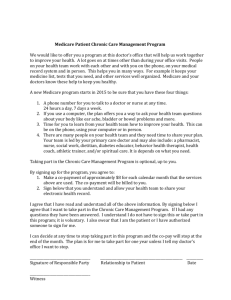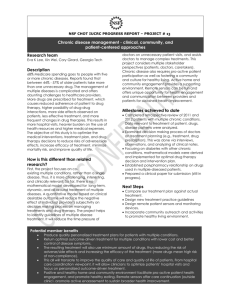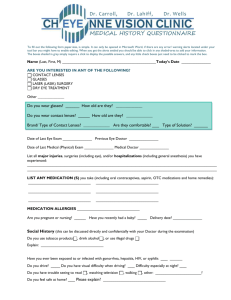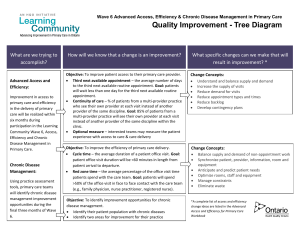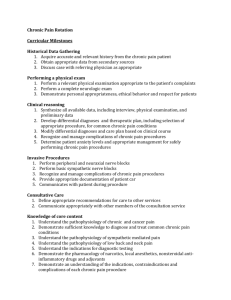ARE WE SPEAKING THE SAME LANGUAGE
advertisement
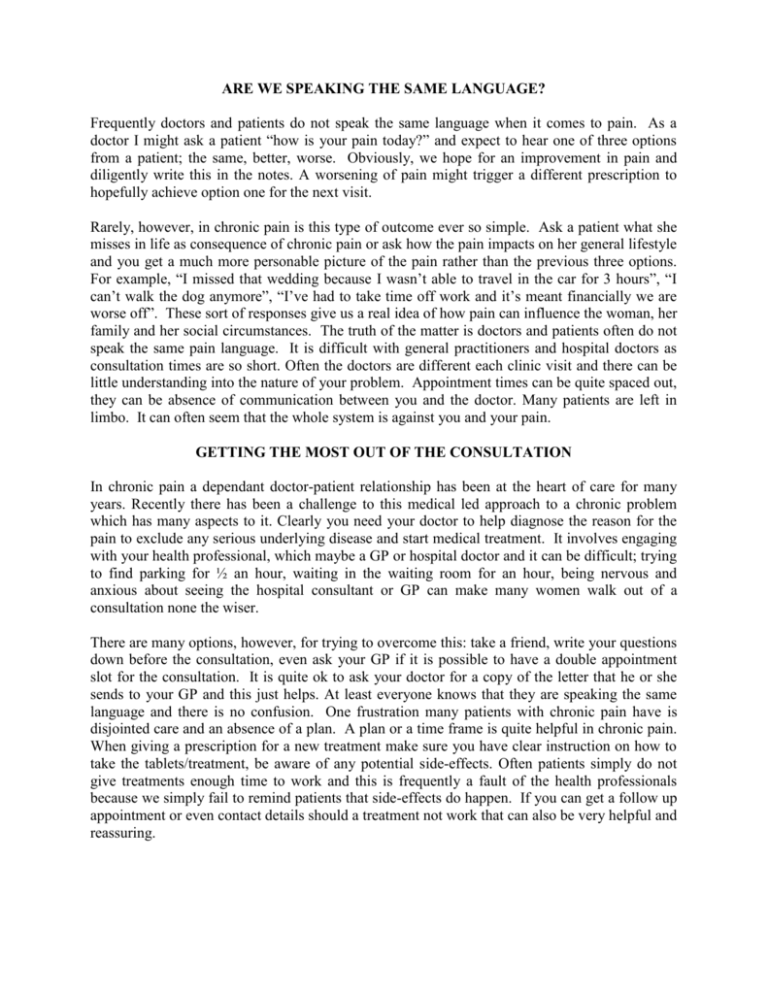
ARE WE SPEAKING THE SAME LANGUAGE? Frequently doctors and patients do not speak the same language when it comes to pain. As a doctor I might ask a patient “how is your pain today?” and expect to hear one of three options from a patient; the same, better, worse. Obviously, we hope for an improvement in pain and diligently write this in the notes. A worsening of pain might trigger a different prescription to hopefully achieve option one for the next visit. Rarely, however, in chronic pain is this type of outcome ever so simple. Ask a patient what she misses in life as consequence of chronic pain or ask how the pain impacts on her general lifestyle and you get a much more personable picture of the pain rather than the previous three options. For example, “I missed that wedding because I wasn’t able to travel in the car for 3 hours”, “I can’t walk the dog anymore”, “I’ve had to take time off work and it’s meant financially we are worse off”. These sort of responses give us a real idea of how pain can influence the woman, her family and her social circumstances. The truth of the matter is doctors and patients often do not speak the same pain language. It is difficult with general practitioners and hospital doctors as consultation times are so short. Often the doctors are different each clinic visit and there can be little understanding into the nature of your problem. Appointment times can be quite spaced out, they can be absence of communication between you and the doctor. Many patients are left in limbo. It can often seem that the whole system is against you and your pain. GETTING THE MOST OUT OF THE CONSULTATION In chronic pain a dependant doctor-patient relationship has been at the heart of care for many years. Recently there has been a challenge to this medical led approach to a chronic problem which has many aspects to it. Clearly you need your doctor to help diagnose the reason for the pain to exclude any serious underlying disease and start medical treatment. It involves engaging with your health professional, which maybe a GP or hospital doctor and it can be difficult; trying to find parking for ½ an hour, waiting in the waiting room for an hour, being nervous and anxious about seeing the hospital consultant or GP can make many women walk out of a consultation none the wiser. There are many options, however, for trying to overcome this: take a friend, write your questions down before the consultation, even ask your GP if it is possible to have a double appointment slot for the consultation. It is quite ok to ask your doctor for a copy of the letter that he or she sends to your GP and this just helps. At least everyone knows that they are speaking the same language and there is no confusion. One frustration many patients with chronic pain have is disjointed care and an absence of a plan. A plan or a time frame is quite helpful in chronic pain. When giving a prescription for a new treatment make sure you have clear instruction on how to take the tablets/treatment, be aware of any potential side-effects. Often patients simply do not give treatments enough time to work and this is frequently a fault of the health professionals because we simply fail to remind patients that side-effects do happen. If you can get a follow up appointment or even contact details should a treatment not work that can also be very helpful and reassuring. TURNING THE VOLUME DOWN Chronic pain can be a way of life for many people and there are many ways of turning the volume of this pain down that involve not only medical treatments but lifestyle changes. Much of the current medical approach to chronic pain is based on drugs taken by mouth, these can include simple painkillers such as Paracetamol, anti-inflammatory tablets and Codeine type preparations. These are often safe to take and very helpful in pain when taken regularly or even just with flareups. There are many drugs prescribed specifically for chronic pain such as the Tricyclic antidepressants i.e. Gabapentin, Lyrica, these drugs are taken on a continual basis often on an increasing dosage to help re-programme the nerves and turn that pain sensation down; they do not often work completely but can reduce the intensity of the day-to-day pain. A good way of recording the effectiveness of a treatment is to keep a pain diary, this is a daily score using a visual analogue scale, imagine a line 10cms long 0 is at one end, 10 is at the other, score 10 is the worse pain ever, 0 out of 10 is no pain, you should record your pain on a day-to-day basis along this line and it gives you an idea of how your pain maybe improving or even not responding to treatment. As a general rule pain more than 5 out of 10 is considered as moderate. SHIFT FROM DOCTOR TO PATIENT As mentioned above the medical model does not always work because there can be a heavy reliance on medical treatments such as drugs to help the pain and symptoms. There is increasing emphasis now amongst chronic pain experts to shift the emphasis from the doctor to the patient, i.e. patient centred care. Chronic pain has many different facets to it, the level of pain you experience on a day-to-day basis can be influenced by many different factors. Factors contributing to the pain experience include: stress, anxiety, side-effects of the treatment, failure to respond to the treatment, tiredness, work and social losses and flare-ups of pain. Becoming engaged with your own care is a crucial step towards helping turning down the volume of pain that you are experiencing. Engaging in your treatment, taking an interest in your problem is extremely helpful rather than depending on the medical model where often it is at crisis point that individuals can end up calling out emergency GP’s or even end up in Casualty Departments. Education is crucial and there are a number of self-help educational resources available to you on this website. Many women find educating themselves opens up new treatment possibilities and also helps them take existing medical treatments in a more effective way. For some with education and understanding comes acceptance and a discovery of how to live with the problem and help deal with day-to-day pain in a more effective way, cope with flare-ups and begin to have a more fulfilling life. 1. Coping with physical symptoms Many of the drugs that are used in chronic pain have side-effects an understanding of these side-effects and a realisation that when starting a new drug side-effects do subside often helps. Taking drugs at night can help with sleep and can sometimes avoid morning tiredness. Constipation associated with some of the side-effects maybe alleviated by taking a regular laxative. Having painkillers at home for flare-ups when taken regularly might also be another option. These are examples of how drugs can be used to help with specific physical symptoms. Stress and anxiety can lead to heightened physical pain and your perception of pain is higher when stressed. There are many ways of helping to overcome stress and anxiety, breathing exercises, relaxation, massage, quietness can all help. 2. Changing unhelpful behaviour Chronic pain can affect your mood or your general lifestyle. Pain often leads to inactivity, a lack of general exercise and even over compensatory eating and drinking alcohol. This obviously has knock on effects on general fitness, weight gain and body image. Many patients with chronic pain do benefit from an acknowledgment and change in the lifestyle they lead through a combination of pacing, setting goals, getting fitter and becoming more active. Pacing is a valuable skill used in helping manage chronic pain and enables an individual to plan and monitor daily activity levels and having some control over the consequences of pain in their activity. Sometimes with chronic pain it is easy not only to do too little but in some people too much physical activity, an over compensation mechanism, can lead to more pain. This ‘boom-bust’ approach to physical activity can often lead to flareups of pain, it is not the best way to control the pain. Pacing is an established technique in the management of chronic pain by using a slow but progressive series of activity and exercises without using pain as a marker of whether too much exercise has been done. Goal setting as well can be very useful, planning a trip, doing a cruise can give an individual a sense of focus and direction. Getting fitter and becoming more active have many advantages as listed below: Improve muscle bulk, strength, flexibility Reduce joint stiffness Control weight and improve body and flexibility Improve balance and co-ordination Reduce fatigue Sleep and stamina improve Lift of mood, self-esteem and confidence Release body’s endorphins Help manage set backs and flare ups Improve sex life MANAGING MOODS AND UNHELPFUL THINKING Chronic pain particularly vulvodynia has impacts on, not only the individual, but the partner and the family. Anxiety, depression, guilt, frustration are all common emotions felt with chronic pain. Isolation is a big factor as well, as the vulva in society today still remains a difficult area to talk about with friends and family. Isolation should ideally be overcome in this problem as a problem shared is a problem halved and many patients find just sharing their effects of vulvodynia on them, with a friend, family or even a member of a support group can be extremely helpful. Contacting a self-help group or contacts through the website are certainly an option if you have nobody to turn to. MANAGING DIFFICULT LIFE SITUATIONS Finally, the impact of chronic pain on an individual’s life circumstance e.g. finances, housing, work are important knock-on effects as a consequence of chronic pain. These are not easy to deal with but are even harder in isolation and as mentioned above try to discuss these problems with families and friends.

